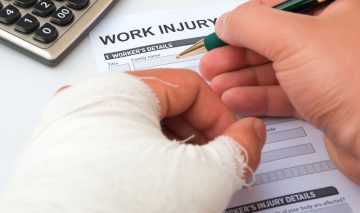
Were You Injured by Faulty Equipment at Work? Don’t Wait to Act!
Originally posted on https://www.injuredcalltoday.com/were-you-injured-by-faulty-equipment-at-work-dont-wait-to-act/
Have You Been Injured at Work?
If you’ve sustained an injury at work due to faulty equipment, this can cause both physical and emotional pain. Work-related injuries can be seen across all sectors of business, both indoors and outdoors. Employees are covered from these injuries with the likes of workers compensation insurance.
Danger is Everywhere
There are several ways that employees can be injured while on the job. One of these ways is by handling faulty equipment. Whether in the construction industry or even a standard office setting, an employee has a chance of sustaining injuries. Here are some of the most commonly known types of injuries collected.
Electrical Injury
Office buildings are surrounded by wiring, extension cords, and electrical outlets. The handling of these pieces of equipment should be handled carefully. If anytime these objects are faulty, it can result in minor shocks or major injury such as electrocutions. Electrical equipment should be kept out of the traffic areas in an office to help avoid any trips and falls. Electrical equipment can also be found on offsite areas such as construction sites and should also be handled with caution. All companies should have safety standards to follow in the event of any electrical injuries occurring.
Physical Injuries
These include any falls, slips that are sustained at work. For example, a slippery surface within the office could cause a physical injury. Any type of abrasion or puncture could be collected using large to smaller office machinery. These include the use of desk office items including staplers, scissors, etc., as well as larger office machinery. The construction industry can see physical injuries after using forklifts, cranes, tractors, excavators, or any other large construction vehicles. Physical injuries can occur in any industry, large or small and should be tended to efficiently. Employers should have emergency supplies available and on-hand such as First-Aid kits, access to water, as well as available escape routes in the event of an immediate emergency.
Chemical Injuries
Being in the presence of certain fumes, gasses, and even dust can result in an injury. Chemical injuries can range from light to severe symptoms including chronic headaches, eye pain, to larger symptoms such as burns. It is always important for employees to be aware of their surroundings; should they smell anything that seems dangerous for instance, they should immediately report this to their employer. If involved in an industry that works with chemicals, employees should have the proper protective gear involved. These include protective eye wear, head gear and protective clothing. They should also know which steps to follow in the event of an emergency such as a chemical spill.
Ergonomic Injuries
These types of injuries are mostly seen in traditional office spaces. If an employer provides their employees with faulty desk chairs for instance, this can result in injuries in the back, spine or neck. Companies should practice following safe and effective ergonomic practices in order to help their employees avoid any injury. Employers can invest in work desks and chairs that promote healthy posture that will lessen any chance of injury.
Radiation Injury
These injuries can be sustained by the misuse of X-rays, gamma rays, or microwaves. Employees in this industry should be given the proper procedures for handling these types of machines in order to avoid injury.
Biological Injury
If an employee deals with any infection after being exposed to a virus, bacteria or fungi. This can occur after a cut, or infection from another contaminated object. Laboratory employees are most known to sustain these kinds of injuries.
Faulty Equipment Liability
Employees can be covered after sustaining a workplace injury by the filing for a Worker’s Compensation Claim. If the employee sustained the injury at their place of employment and with the equipment that belongs to the company, they can file this claim.
Employees should follow a few simple steps in order to begin the process:
- Notify Your Employer In Writing
A verbal indication of the injury sustained will not suffice in the event of an onsite injury. The claim needs to be conducted in writing for legality reasons. Typically, employers have up to 30 days to claim their injury. Within this document, the employer should list the injury with as much detail as possible.
- Seek Medical Attention
After an employee sustains an injury, they should seek medical attention as soon as possible.
- File Your Claim
The employee should file their injury claim on the proper form (more details here).
Safety First
Companies should practice safety measures including following industry standards and procedures to provide the safest working environment for their employees. If an employee does sustain a workplace injury, there are steps and ways to diminish any stress or pain. Filing a worker’s compensation claim, visiting doctor(s) in order to find the best course of action for recovering from the injury.
